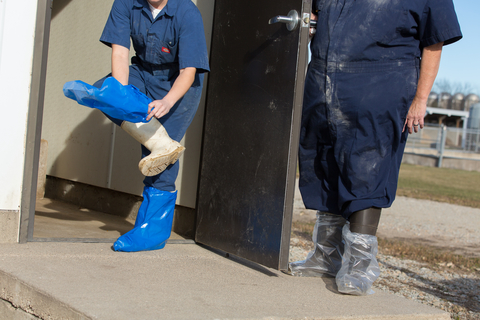
uick facts
Biosecurity is key to preventing and reducing disease risk, including avian influenza.
-
Enforce biosecurity basics including isolation, flow control, sanitation and cleaning and disinfection.
-
Keep biosecurity practices strict, accessible and simple.
-
Know common biosecurity breaks.
Highly Pathogenic Avian Influenza (HPAI) in Minnesota and the Midwest caused great loss to commercial poultry farms in 2015 and 2016. HPAI represents a change in what avian producers had come to expect, given spring introductions of avian influenza are usually rare. Biosecurity is key to preventing or reducing the extent of possible virus introduction.
Biosecurity basics
-
Isolation
-
Flow control
-
Sanitation
-
Cleaning and disinfection
HPAI risk usually occur from indirect or direct contact with virus contaminated
-
People
-
Equipment
-
Wild birds
Line of separation
With introductions into single barns on multi-barn sites, barn biosecurity is key. You need a line of separation around each barn in addition to the separation area for the farm unit. Lines of separation define clean areas from dirty areas.
-
Always assume the area around the barn is contaminated.
-
Avoid bringing outside contamination inside the barn.
-
Have a secure entry of people and equipment to the barn.
Did you know?
Poultry farm survey
A survey of poultry farms by Racicot and coworkers, 2011, 2012 using video and audits to track compliance revealed:
-
Few facilities posted barn entry protocols.
-
Barn entry protocols for farm personnel barn weren’t as strict as visitor protocol.
-
While most farms used some inside/outside separation when entering the barn, few took added precautions such as washing hands and changing to barn specific clothing.
-
People followed entry protocols less closely for short visits.
-
Defining clean and dirty areas at entry influenced protocol compliance. Compliance was less if a physical separation of these areas wasn’t present.
-
Some unidentified individuals were videotaped in the barns.
-
Most biosecurity errors involved cross-contamination of clean areas (barn) and contaminated (outside) at entry.
Danish Entry
The swine industry moved to an entry system called the Danish Entry to overcome problems with swine viruses. The keys to the Danish entry system are:
-
A biosecure entrance to the farm
-
The entrance area has separate clean and dirty areas (line of separation)
-
Upon entry in the “dirty” area:
-
People remove their outer clothing and footwear
-
Wash and disinfect hands
-
Move to a clean area where clean protective clothing, such as boots and coveralls, are provided (boots should be put on before coveralls).
-
-
People complete the protocol in reverse when exiting the building.
Common biosecurity breaks
-
I am only going to spend a few minutes in the barn so I don’t need to put on barn specific clothing.
-
I have an emergency and need to fix a fan, feed line etc. and the tools are in the other barn. I will just run over there quickly and bring them back.
-
I skipped putting on boots, coveralls and/or using hand sanitizer because the supplies weren’t available.
-
I don’t want to give up my lucky ball cap. It goes with me everywhere.
-
The door to the barn is locked and I have an armful of supplies and can’t unlock the door. So I put the boxes on the ground and then unlock the door.
-
I leave the entryway door open for convenience while I’m working in the barn.
-
I was hunting and decided to stop by the farm and see how the flock was doing.
-
I’ll set the dead birds outside the door and deal with them later.
-
Smith is going to work for me over the weekend. Ummm…I think they know the biosecurity protocols?
Avoiding biosecurity errors – barn entry
-
Post barn entry/exit protocols that provides lines of separation.
-
Provide barn-specific clothing, supplies and equipment to reduce traffic between barns and other farm areas.
-
Clean and disinfect anything that enters the barn.
-
Review protocols with farm staff and get input from staff and others on how to improve.



















